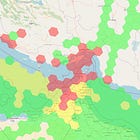U.S. and Israeli Strikes on Iran: Evaluating Risk Of Renewed Escalation
Israeli Defense Minister Israel Katz announced the Israeli military is preparing for additional operations to maintain air superiority and prevent Iran from rebuilding its nuclear, missile programs.
MIDDLE EAST — On Tuesday, June 24, 2025, a ceasefire took effect following coordinated U.S. and Israeli airstrikes on Iranian nuclear and military facilities, concluding a 12-day conflict initiated by Israel on June 13, 2025. The U.S. deployed 14 GBU-57 Massive Ordnance Penetrators (MOPs)—30,000-pound bunker-buster bombs—on the Fordow nuclear facility near Qom on June 22, 2025, severely damaging its centrifuge cascade hall and halting Iran’s uranium enrichment to weapons-grade levels.
Israel targeted missile and drone storage sites in Kermanshah and Bandar Abbas, as well as Islamic Revolutionary Guard Corps (IRGC) and Basij headquarters in Tehran, resulting in 200 to 300 personnel casualties in the 24 hours before the truce.
Despite the ceasefire, Israel’s targeted killing of Iranian nuclear scientist Soleiman Soleimani on Friday, June 27, 2025, and Iran’s threats to resume nuclear activities indicate a sustained risk of escalation.
At a Pentagon press conference on Thursday, June 26, 2025, Secretary of Defense Pete Hegseth stated, “President Trump directed the most complex and secretive military operation in history. And it was a resounding success, resulting in a ceasefire agreement and the end of the 12-Day War.”
Acronym Index
DTRA: Defense Threat Reduction Agency
IDF: Israel Defense Forces
IRGC: Islamic Revolutionary Guard Corps
ISW: Institute for the Study of War
MOP: Massive Ordnance Penetrator
PIJ: Palestinian Islamic Jihad








